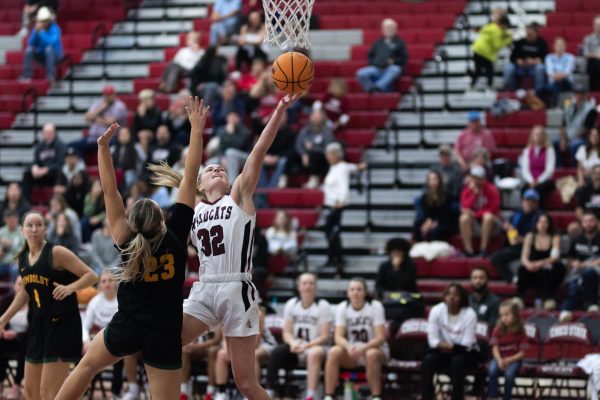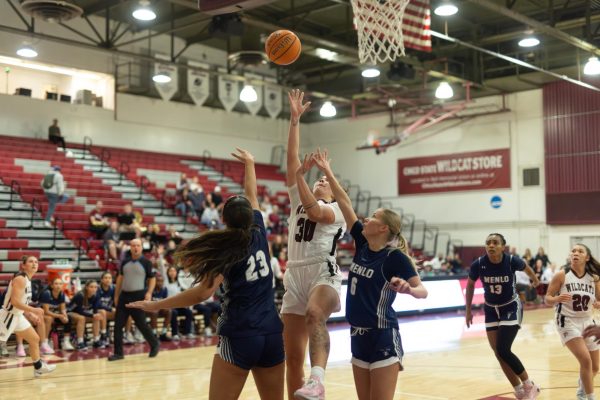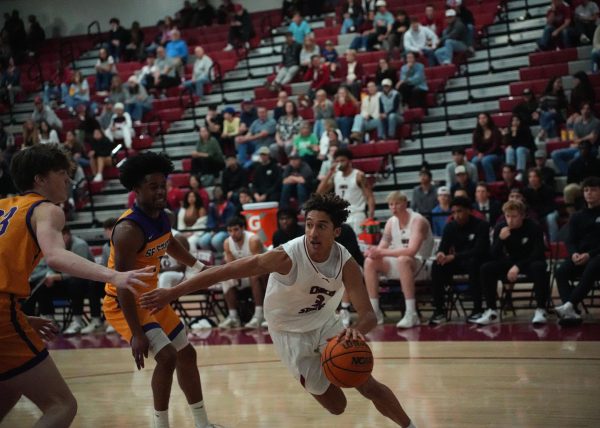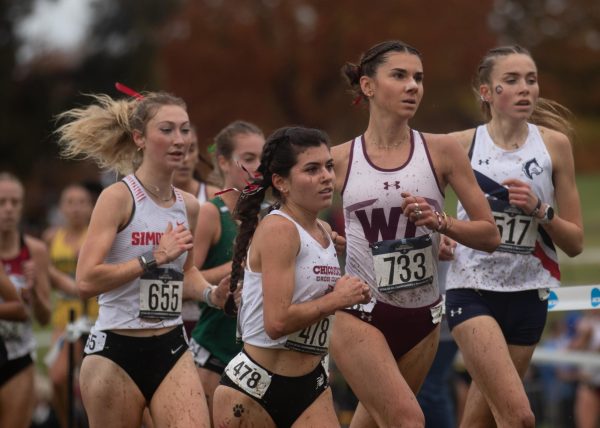Wildflower Century brings together Chico’s cycling community
Bikers congregate at the finish line after completing their races. Photo taken April 24 by Mason Tovani
My experience from behind the handlebars — Noah Herbst
The chilly, morning breeze tickled at my face, blowing through the holes in my helmet as the occasional truck sped by. I clung to the narrow piece of asphalt that constituted the bike lane. I was somewhere in the early-20s mile mark, my calves and thighs swelled with lactic acid and my glutes felt like they were on fire.
If this scenario sounds familiar to you, it’s likely because you’ve experienced the wonders of riding a bike. For many, myself included, cycling serves as a form of exercise, stress-relief, fun and transportation. Nowhere is this more apparent than at Wildflower Century, an annual event hosted by Chico Velo. In this year’s Wildflower Century cyclists took part in one of seven routes, anywhere from 12 miles to 125 miles. The all-day event took place on April 24, attracting riders of all ages, entire families and die-hard cyclists.
I participated in Flatflower 30, a 31-mile, largely flat route that took riders from The Silver Dollar Fairgrounds to the outskirts of Durham, through the town’s center and back to Chico.
I chose the 30 because I wanted to challenge myself with more than the Flatflower 12, but I knew that if I tried to do the Flatflower 60 I likely would have ended up passed out somewhere on the side of the highway, halfway between Chico and Gridley.
There was no way I was going to undertake the impressive feat of biking in one of Wildflower Century’s most popular routes, the traditional Wildflower 100, the Wildcat 100 and the Wildcat 125, a 125-mile long route that takes you throughout the county with an elevation gain of nearly 7,000 feet. As a newcomer, I possessed neither the endurance nor the leg strength to take on such a challenge.
Even though this was my first time participating in the Wildflower Century, the event attracted many veterans. Chico Velo’s Board of Directors President, Mandi Mckay said this year had about 2,000 cyclists in attendance. Mckay was happy with the turn out, especially because this was the first Wildflower Century since the start of the pandemic. In the past, the event has reached as many as 4,000 attendees.
However, COVID was not the only obstacle Chico Velo had to overcome. They had some last minute re-routing to do because the Honey Run Covered Bridge was damaged by the Camp Fire in 2018. The bridge and the Honey Run Climb, a road connecting Chico to Paradise, were both previously key parts of the longer, more advanced routes. Both had to be cut for this year’s event, but they still managed to keep all routes to the same distances they had been prior to the pandemic.
“[It’s] not ideal, but we made the best of it, and we’re really hoping to bring back the original route next year,” McKay said. “People miss the Honey Run Bridge, they miss the Honey Run climb. … that’s pretty iconic for Wildflower.”
As McKay facilitated the event, I rode with a small group of cyclists on the Durham-Dayton Highway. I started at the Silver Dollar Fairgrounds a few minutes shy of 8 a.m., and was now around the thirty minute mark. I kept a steady speed and tried not to let the occasional rider who passed me dissuade me, afterall, it was a marathon not a sprint.
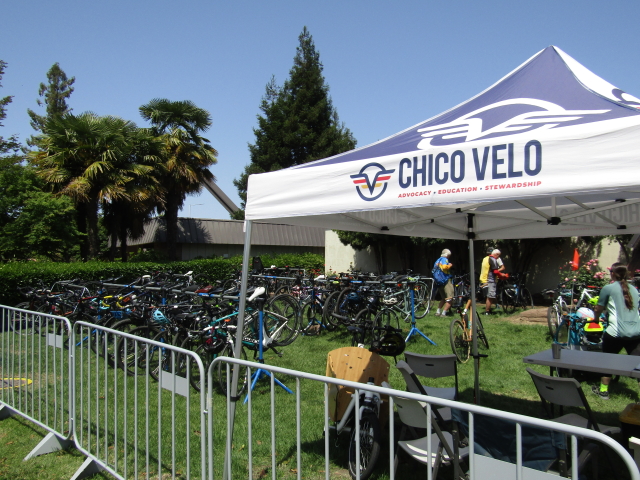
McKay, a Chico State alumna, said she’s been on the board for “seven to eight years now.” Before that she rode her bike to campus and participated in various Wildflower Century routes.
“I used to ride this event all the time, I rode it every year for probably eight years and then I joined Chico Velo and now I’ve worked it every year,” Mckay said with a laugh.
“I’d love to ride it again but since I’ve been on the board, I kind of have to work it!”
Just before 9 a.m. I reached Durham Elementary School, a designated rest stop near the halfway point. Chico Velo members handed out snacks and water. As tempting as the goodies were, I only stopped for a moment to check things out before carrying on with my route. I knew the longer I stayed, the less I would want to get back on my bike.
By 9:45 a.m. I had passed the halfway point, but my energy level had dipped significantly. Although, it certainly didn’t help that after my stopping at the school I then proceeded to bike two miles in the wrong direction before realizing my mistake and getting back on course.
Not long after, I began to loathe my bike seat. Somewhere around the 19 mile mark, right before the intersection of Grainland and Aguas Frias Road, my legs began feeling sluggish. To avoid thinking about my growing discomfort, I focused on the area’s natural beauty, like the miles of orchards around me, the occasional dry river bed and the snow-capped coastal mountain range that towered in front of me or the Sutter Buttes off in the distance to my left.
A little background on how I trained for the Flatflower 30: I didn’t. Most of my biking is done out of leisure, and on good weeks, I’ll get a couple 20-mile rides in. Going into the event, I was a little nervous, as I’d never done thirty miles straight and typically, I take my sweet time. Here, I had to set a personal record, and I wanted to get it done in no more than 3 hours.
It was nearing 10:30 a.m. and I was nearing mile 25 when I rode back into Durham from the surrounding countryside. I was making another stop at Durham Elementary School to refill my water when I saw Dr. Jacob Brimlow, a professor at Chico State’s College of Agriculture and a member of Chico Velo’s board of directors. Brimlow and his 5-year-old son had been tasked with leading the Flatflower 12, and Durham Elementary School was their half-way point.
Like McKay, Brimlow is also a Chico State graduate, board member and a life-long cyclist.
“I believe really strongly in biking as a lifestyle,” Brimlow said. “It feels really good to me to help support awareness as well as promote safety through education.”
After a quick visit, I was back on my bike. With about half an hour left and six miles to go, I mustered up the stamina I still had left and raced down the Midway Bike Path back to the Silver Dollar Fairgrounds.
Just before 11 a.m. I sped into the fairground parking lot where other recently finished bikers had congregated. My goal of completing the Flatflower 30 and doing so in 3 hours or less had been accomplished. The crowd stood and cheered for the riders returning from the various routes, with many heading deeper into the fair grounds to enjoy their free meal.
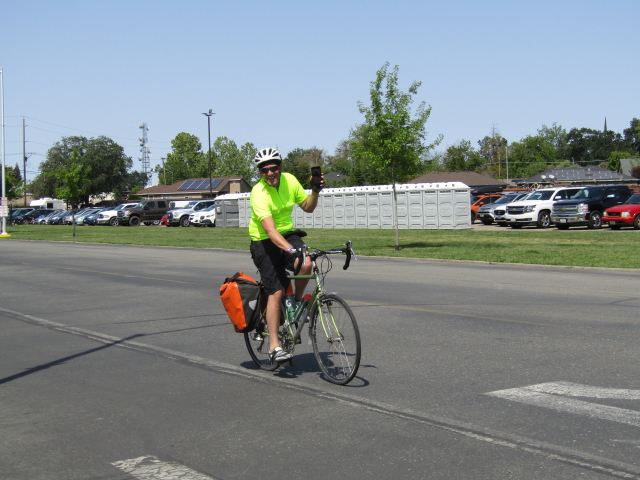
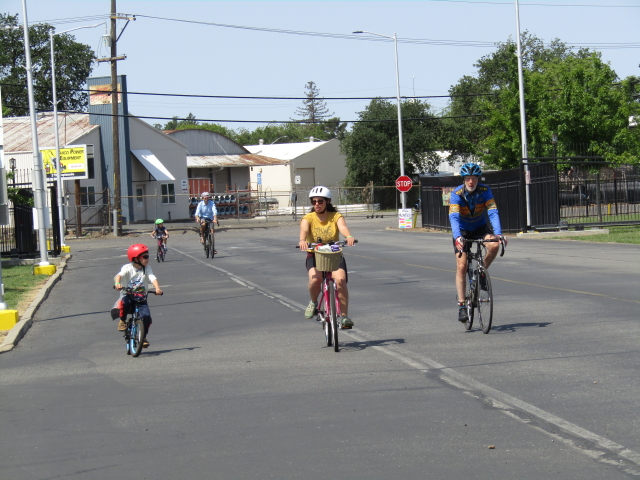
I thought about sticking around for the Wildflower and Wildcat riders to get back, if I was tired I couldn’t begin to imagine what they would feel like when they finished their journeys. After learning that they might not be back for a couple more hours, I snapped a few more pictures and loaded my bike into my car.
Had I really put my mind to it, I could have waited it out for the other riders, but at that point I had only one thing on my mind — a long nap.
Ability First Sports participates in annual Wildflower Century — Mason Tovani
Hosts of the event, Chico Velo, made their annual ride more accessible to everyone looking to participate. In specific Ability First Sports the routes were available to all riders as well as bathrooms throughout. Along with allowing drivers on the road to assist with any equipment issues Ability First riders may have run into.
Ability First Sports was created in 1985 by Eric Snedeker, a former Chico State professor in the Physical Education department and assistant coach of the men’s soccer team. Ability First has provided over 1,000 wheelchair athletes in the Western United States access to an active lifestyle.
Almost all in participation were not strangers to riding long distances, their spandex and colorful dri-fit shirts indicated that. The sleek sunglasses to block the wind from drying out their eyes and the water bottle holder in between the frames of their bikes indicated that as well.
Some, however, don’t have these same luxuries.
A select few at the Silver Dollar Fairgrounds two weekends ago seized the moment and their smiles never dissipated as they parked the bikes underneath their program’s canopy.
The Wildflower ride consisted of distances ranging from 12-125 miles, the masses at the ride were looking to push their own limits. The content cruised for the 30 mile ride, the brave embarked for 60 miles, and for the ambitious, they journeyed the looming 125.
But for the courageous, it was a fulfilling 12 miles. Sometimes less is more.
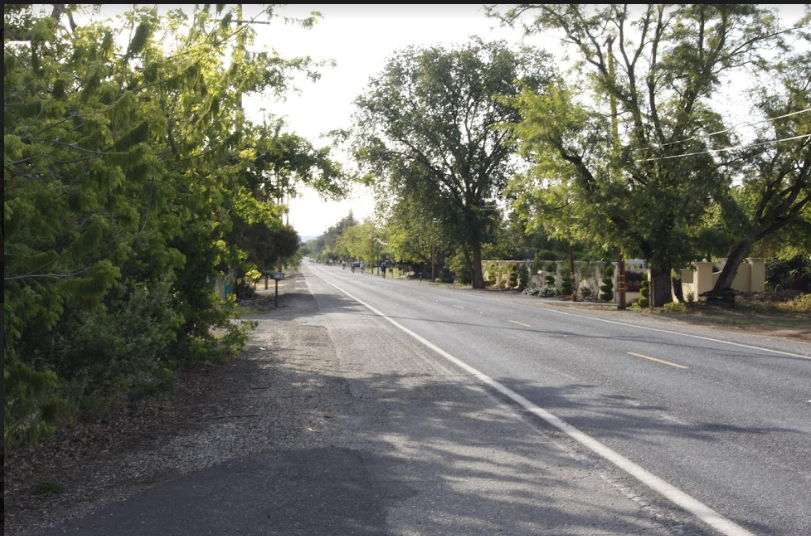
“We have a parent whose daughter has only pushed a mile in her life and I just got a text that she completed six miles,” Snedeker said. “We figured we’d have to give her a ride back but she said ‘No I want to finish the race.’”
The youngest athlete Ability First had competing at the Wildflower ride was 5-years-old and all of the athletes had physical limitations ranging from spinal cord injuries to cerebral palsy.
Those who took part in the race trained for a few months ahead of the ride. Snedeker said it’s all about encouragement and allowing their athletes to move beyond what they thought they could do.
“A lot of our kids don’t have that opportunity for someone to encourage them to go out and do what able-bodied people can do,” Snedeker said. “We had a couple kids who got here and said they were nervous, I said that’s good, that’s exactly what you should be before you go out and push your limits.”
Many of the activities are specific to the number of people involved, sports such as basketball where a court and 10 participants are required.
With biking, however, all you need is two or three wheels and the open road. Although, a friend or two tagging along always calls for an opportune time.
Snedeker and Ability First hopes the Wildflower ride is a stepping stone for their athletes to be inspired and continue to participate.
“This is an activity where anyone can go grab their brothers, sisters or family and go out for a ride through Bidwell,” Snedeker said. “We’re able to loan the equipment out to them and they can return it three, four or five months later.”

Riding alongside the Ability First athletes was Patrick Caronan, a public health major at Chico State. Caronan has a deep passion for helping those with disabilities and was moved to see an event involving those with physical limitations.
“I have a brother who is disabled and I was so touched to see that they had an event like this for people with all kinds of abilities able to participate,” Caronan said. “So once everything got figured out I was of course willing to help.”
Pedaling next to and assisting an Ability First athlete who used a handbike for 12 miles was the highlight of the ride for Caronan.
A handbike is exactly what it sounds like. Three wheels, one in the front and two in the back while your arms move in a circular motion, powering the bike as your legs are placed outward on a platform.
In the hot sun, pushing just beyond eight miles, Caronan said they were picked up by on-call assistants. But her perseverance was nothing short of inspirational and showed how much of a trooper she was, Caronan said.
“Seeing the spirit and camaraderie between Ability First riders and other riders, and how accommodating they were, we were cheering them on and they were cheering us on,” Caronan said. “It was great to be around such positive energy and it’s the reason I’ll be back helping out with more events.”
After a few years away from physical camp, Ability First is now holding their first ever adapted sports retreat this summer from June 16-19. Campers will be participating in a multitude of activities, ranging from tennis to water skiing. And by the looks of their Instagram, the same spirit and camaraderie Caronan mentioned, is present whenever the campers come together.
The message Ability First Sports spreads is short and simple: “We seek to break down physical, mental and social barriers among people with physical challenges to become active for a lifetime.”
Noah Herbst and Mason Tovani can be reached at [email protected].




